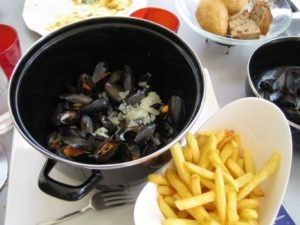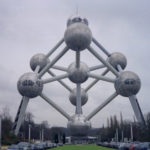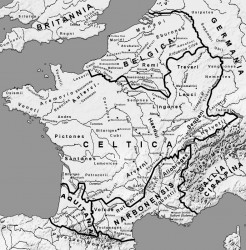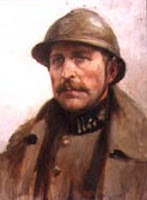TEN PROPHETIC CLUES CONCERNING ASHER – WALLOONS (BELGIANS)
There is no direct history connecting the tribe of Asher to the Belgian people.We are talking about one of the lost tribes. Even the Caucasian population of Wallonia comes from various backgrounds.One can compare this with Jewry. The Jewish people have known many proselytes. Yet there has been a core of the tribe of Judah (and some of Levi & Benjamin) over the past 2500 years. The core passes on characteristics and genes to the periphery. Looking at the ‘prophetic clues’ one has to conclude that a core of the tribe of Asher once found its way to the people living in Belgium and Luxemburg (especially in the triangle Roermond-Lille Nancy-Roermond).This core passed on its characteristics and genes to the influx of others. The more fulfilled prophetic clues we find, the stronger our case. What follows is not historic proof, but proof by revelation.
1st Clue: Asher – happy
And Zilpah Leah’s maid bare Jacob a second son. And Leah said, HAPPY am I [b _ashri], for the daughters will call me BLESSED [ishruni]: and she called his name Asher [asher: blessed, happy] (Gen 30:12-13).
And Zilpah Leah’s handmaid bore Jacob a second son. And Leah said: ‘HAPPY am I! for the daughters will call me HAPPY.’ And she called his name Asher [HAPPY or BLESSED] (Gen 30: 12-13, JPS, Jewish Publication Society).
After four sons Leah has two more sons by her maid servant Zilpah. Asher is Jacob’s 8th son. They will call me happy, and she names him ‘blessed, happy’, Asher! This predicts Asher’s nature: jovial, genial, friendly.
‘Burgundian’ lifestyle
The national character of most Belgians in general, and Walloons in particular, is that they are jovial, genial, friendly. They live what is called in Dutch a ‘Burgundian life’. The Belgians are epicurean, loving food and finer things. They are gourmets and gourmandizing. The Dutch expression is that they are leading a Burgundian life.
Dutch Wikipedia about the Burgundian life:
Burgundian is used as an adjective to express that life is enjoyed. This phrase comes from the dukes of Burgundy… Well-known dukes of Burgundy were Philip the Good and Charles the Bold. Their court was known for great luxury and riches. The people of the southern Dutch provinces North-Brabant and Limburg and the Belgians are often called ‘Burgundian’, because they like taking time to enjoy a bite or a drink.
Walloons, Flamands & Belgians
DNA shows that Walloons and Flemish people are more related than some of them would like to know. In the 19th century many Flemish moved into Wallonia. Dutch Wikipedia says about ‘Belgians’:
The existence of Belgians as a people have been the subject of many discussions. The best-known quote for this is … “There are Flemish people (Dutch speaking) and Walloons (French speaking). There are no Belgians… “. In spite of all their differences, it is generally accepted that they have quite a few things in common. Thus Belgians are known to be modest, raised as catholics and loving the ‘Burgundian life’.
Belgians are bons vivants.
2nd Clue: Asher – his bread shall be fat
As for Asher, his BREAD [lechem] shall be FAT [shamen]… (Gen 49:20a, KJV).
Asher’s FOOD will be RICH … (Gen 49:20a, NIV). Literally it says that Asher’s bread will be fat. It is noteworthy that bread in England and Holland has the form of a big brick, a loaf. In France they sell the typical French bread, long thin pieces of bread. In Belgium they sell bread in big, round, ‘fat’, loaves.
However, lechem also means food in general, and not just bread. Asher’s food would be rich in content, and it would be plenteous.
Belgian Cuisine
Wikipedia about the Belgian cuisine: Belgian cuisine is widely varied with significant regional variations while also reflecting the cuisines of neighbouring France, Germany and the Netherlands. It is sometimes said that Belgian food is served in the quantity of German cuisine but with quality of French food. Outside the country, Belgium is best known for its chocolate and beer. Belgian cuisine traditionally prizes regional and seasonal ingredients, leading to distinctive dishes like carbonade flamande in Flanders or couque biscuit of the town of Dinant. Belgians typically eat three meals a day, with a light breakfast, light or medium sized lunch and large dinner …
Fries
Fries, deep-fried chipped potatoes, are very popular in Belgium where they are thought to have originated. The earliest evidence of the dish comes from a book entitled Curiosites de Ia table dans les Pays-Bas-Belgiques written in 1781, which described how inhabitants of Namur, Dinant and Andenne around the Meuse River had eaten fried potatoes since around 1680. Though they are usually known as “French fries” in the United States, it is argued that American soldiers during the First World War erroneously believed that they were being served the dish in France.
In Belgium, fries are sold at fast food stands or in dedicated fast-food restaurants called “friteries” or “fritkot”. They are often served with a variety of sauces and eaten either on their own or in the company of other snacks. Traditionally, they are served in a “cornet de frites”, a cone-shaped white piece of cardboard then wrapped in a piece of paper with the sauce on the top. Other street foods like frikandel, gehaktbal or croquette are sold alongside. In some cases, the fries are served in the form of a sandwich along with their sauce and meat known as a “mitraillette”.
Most Belgian households have a deep fryer, allowing them to make their own fries and other deep-fried foods at home.
Asher’s food would be fat, would be rich.
3rd Clue: Asher– royal dainties
Out of Asher his bread shall be fat, and he shall yield royal DAINTIES (Gen 49:20b).
[Asher] will provide DELICACIES fit for a king (Gen 49:20b, NIV).
This is up to a point a repeat of the fact that Asher’s food would be fat or rich. We think of all the delicacies-fries, mussels, oysters, fish, venison, etc. -served in the Belgian cuisine, but ‘delicacies’ contains much more.
Belgian Beers
Wikipedia: For a comparatively small country, Belgium produces a very large number of beers in a range of different styles- in fact, it has more distinct types of beer per capita than anywhere else in the world. In 2011, there were 1,132 different varieties of beer being produced ithe country. The brewing tradition in Belgium can be traced back to the early Middle Ages and 6 varieties are still produced in Trappist Monasteries where brewing was initially used to fund their upkeep. On average, Belgians drink 84 litres of beer each year, down from around 200 each year in 1900. Most beers are bought or served in bottles, rather than cans, and almost every style of beer has its own particular, uniquely shaped glass or other drinking-vessel. Using the correct glass is considered to improve its flavour.
The varied nature of Belgian beers makes it possible to match them against each course of a meal, for instance:
-Wheat beer with seafood or fish.
-Blonde or Tripel beers with eel, chicken or white meat
-Dubbel or other dark beers with dark meat
-Fruit Lambics with dessert
A number of traditional Belgian dishes use beer as an ingredient.
Belgian pralines
(Photo: Wikipedia)
Belgian Chocolate
Wikipedia about Belgian chocolate: Belgium is famed for its high quality chocolate and over 2,000 chocolatiers, both small and large. Belgium‘s association with chocolate goes back as far as 1635 when the country was under Spanish occupation and during the early 20th century, the country was able to lmport cocoa from its colony, the Belgian Congo. Today, chocolate is very popular in Belgium, with 172,000 tonnes produced each year, and widely exported.
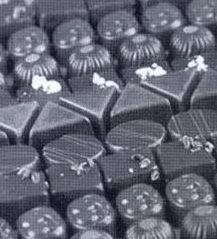 What makes Belgian chocolate unique is the quality of ingredients (many aspects of its composition are regulated by law) and adherence to traditional manufacturing techniques. In particular, vegetable based fats are not used. Many firms produce chocolates by hand, which is laborious and explains the prevalence of small, independent chocolate outlets, which are popular with tourists. Famous chocolate companies, like Neuhaus and Guylian strictly follow traditional (and sometimes secret) recipes for their products.
What makes Belgian chocolate unique is the quality of ingredients (many aspects of its composition are regulated by law) and adherence to traditional manufacturing techniques. In particular, vegetable based fats are not used. Many firms produce chocolates by hand, which is laborious and explains the prevalence of small, independent chocolate outlets, which are popular with tourists. Famous chocolate companies, like Neuhaus and Guylian strictly follow traditional (and sometimes secret) recipes for their products.
Seafood pralines (pralines shaped like sea shells or fish) are popular with tourists and are sold all over Belgium.
Waffles and sweets
There are also Belgian waffles (Brussels, Liege), speculoos, vlaaien (Limburg), sweets, etc. Asher ‘s food would be rich and he would yield royal dainties.
Tapestries, lace, comic books
Delicacies or dainties is a translation from ma’adan: Ma’adan – or (feminine) ma’adannah {mah-ad-an-naw’}; from ‘ ‘adan’ (Strong, 5727); a delicacy or (abstractly) pleasure (adverbially, cheerfully):- dainty, delicately, delight.
Some writers about the tribes link this with the typical Belgian delicate tapestries (made for royalty!) and with Belgian lace.
Belgium is also renowned for its comic books: Tintin, Spike & Suzy, The Smurfs, Lucky Luke, etc. To many Europeans a ‘delight’.
4th Clue: Asher- friendly & favoured
And of Asher he said: Blessed be Asher above sons; let him be the FAVOURED of his brethren … (Dt 33:24, JPS).
And of Asher he said, Let Asher be blessed with children; let him be ACCEPTABLE to his brethren, … (Dt 33:24, KJV).
About Asher he said: “Most blessed of sons is Asher; let him be FAVOURED by his brothers, …”(Dt 33:24, NIV).
Belgians – kind, friendly
Although Belgians may fight between themselves about language problems – a bloodless struggle – they are perceived by others as kind, friendly people. To my knowledge there are not many people who hate Belgians. The French and the Dutch may joke about Belgians, but they do not dislike them. The fact that they are liked by their neighbours, by other tribes, has been favourable to them over time.
Belgium’s Independence
Many countries had to fight for years for independence, often at the cost of many deaths. Belgian independence was more or less given to them. In 1830 the Belgians seceded from the Netherlands during the Belgian Revolution. They were soon supported by France and England. Queen Victoria came up with the name Belgium and her cousin Leopold became king. There was a 10 day fight with the Netherlands, but the Dutch (Zebulun) were forced by the English (Ephraim) and the French (Reuben) to back off. Thus the Belgians (Asher) got their country with hardly any bloodshed. They were ‘favoured’ by their brethren.
Colonial power
Likewise Belgium became a colonial power without much sweat and toil. The Spanish, Portuguese, French, English and Dutch conquered their colonies fighting each other, not so the Belgians. In 1908 Belgium received the Congo from king Leopold II, who in turn had received it during the Berlin Congress of 1885.
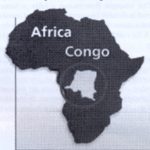 The reign of terror in the Congo Free State under Leopold II led to the annexing of the Congo by Belgium in 1908. Until its independence the Belgian Congo (2,345,000 km2) was to Belgium what Indonesia (1,919,000 km2) was to Holland. The Congo is 75 times Belgium. England (Ephraim) and France (Reuben) fought each other over colonies, but they gave the Congo to Leopold (and later to Belgium). Another example of Asher being favoured by his brothers.
The reign of terror in the Congo Free State under Leopold II led to the annexing of the Congo by Belgium in 1908. Until its independence the Belgian Congo (2,345,000 km2) was to Belgium what Indonesia (1,919,000 km2) was to Holland. The Congo is 75 times Belgium. England (Ephraim) and France (Reuben) fought each other over colonies, but they gave the Congo to Leopold (and later to Belgium). Another example of Asher being favoured by his brothers.
Ruanda-Urundi
When German East Africa was divided up after WW I, the Belgians received Ruanda-Urundi (54,000 km2), until their independence (Rwanda & Burundi) in 1962. Thus expanding their African colonial empire.
Poor Little Belgium
Because the Germans violated Belgium’s (Asher) neutrality in 1914, the English (Ephraim) went to war. To save poor little Belgium! Poor little Belgium became the war cry in the propaganda campaign against the Germans. In 1917 the Americans (Manasseh) used the same theme to mobilise the home front. Belgium (Asher) had to be saved.
EEC – EC – EU & NATO
Another example which shows clearly that Belgium is looked favourably upon, is the development of the EEC-EC-EU. Originally the European institutions had to be spread out over Strasburg, Luxemburg and Brussels. Over time most of the European institutions have ended up in Brussels. Brussels was also elected as NATO headquarters.
5th Clue: Asher- … iron … under your shoe
Thy shoes shall be IRON and brass ... (Dt 33:25). YZER en koper zal onder uw schoen zijn … (Dt 33:25, SVV, Dutch Staten Vertaling: IRON and copper will be under your shoe).
An important prophecy concerning Asher is about metal. And of Asher he said … IRON and brass (or copper) will be your shoe, or will be under your shoe. The triangle Roermond – Lille – Nancy – Roermond is closely connected with iron, coal and industrialisation. To speak of Wallonia is to speak of iron. A lot can be read about the Wallonian steel industry.
Wikipedia: Wallonia is rich in iron and coal, and these resources and related industries have played an important role in its history. In ancient times, the Sambre and Meuse valley was an important industrial area in the Roman Empire. In the Middle Ages, Wallonia became a centre for brass working and bronze working, with Huy, Dinant and Chimay being important regional centres. In the 12th and 13th centuries, the iron masters of Liege developed a method of refining iron ore by the use of a blast furnace, called the Walloon Method. …
In the 19th century, the area began to industrialize, mainly the so-called sillon industriel. It was the first fully industrialized area in continental Europe, and Wallonia was the second industrial power in the world, in proportion to its population and its territory, after the United Kingdom. The sole industrial centre in Belgium outside the collieries and blast furnaces of Wallonia was the historic cloth making town of Ghent.
Wikipedia about the Walloon Method: The technique was developed in Wallonia in present day Belgium during the Middle Ages. The Walloon method consisted of making pig iron in a blast furnace, followed by refining it in a finery forge. The process was devised in the Liege region, and spread into France and thence from the Pays de Bray to England before the end of the 15th century. Louis de Geer took it to Roslagen in Sweden in the early 17th century, where he employed Walloon ironmakers. Iron made there by this method was known in England as oregrounds iron.
The Atomium
The Atomium is an expression of Belgium’s link with iron. Wikipedia: The Atomium is an iconic building in Brussels originally constructed for Expo ’58, the 1958 Brussels World’s Fair. Designed by the engineer Andre Waterkeyn and architects Andre and Jean Polak, it stands 102 m {335 ft) tall. Its nine 18 m {59 ft) diameter stainless steel clad spheres are connected so that the whole forms the shape of a unit cell of an iron crystal magnified 165 billion times. Asher … iron under his shoe.
More iron …
It is noteworthy to see that iron keeps popping up in Belgian life and history. The Duke of Alba ruled the Low Countries (1567 – 1573) for the Spanish King Philip II. Because of his reign of terror from Brussels he was called the ‘Iron Duke’.
Iron is Yzer in Dutch, pronounced [aizer]. In West Flanders there is the small river, the Yser. Here the Belgian forces made a stand against the German invaders in 1914. This gives the Battle of the Yser, the Yser Tower after the war and the Yser Tower Pilgrimage.
To ensure a better connection between the port of Antwerp and the industrial Ruhr Gebiet in Germany a special railroad was constructed, called the Iron Rhine. With regards to railroads it is also worth mentioning that Belgium is the country with the highest density of railway lines. A railroad is called in French ‘chemin de fer’, literally a ‘road of iron’. This nicely fits Asher again: iron under his shoe …
6th Clue: Asher- … brass … under your shoe
Thy shoes shall be iron and BRASS … (Dt 33:25). Yzer en KOPER zal onder uw schoen zijn … (Dt 33:25, SVV, Dutch Staten Vertaling: iron and COPPER will be under your shoe).
As we saw: In the Middle Ages, Wallonia became a centre for brass working and bronze working, with Huy, Dinant and Chimay being important regional centres {Wikipedia).
Belgium – Congo – Katanga – Copper
The Katanga Province of Belgian Congo was one of the world’s most important copper producing areas in the twentieth century until the 1960’s. Belgium became an important importer and exporter of copper. The copper was extracted by the Union Miniere du Haul Katanga.
Union Miniere du Haul Katanga
Wikipedia: The Union Miniere du Haut Katanga (UMHK) was a Belgian mining company, once operating in Katanga, in what is now the Democratic Republic of the Congo (formerly, Congo Free State, from I908, Belgian Congo, from I972, Zaire).... It was created on October 28, 1906 … and was granted mining concessions in I900), in order to exploit the mineral wealth of Katanga. It was owned jointly by the Societe Generate de Belgique, Belgium‘s largest holding company (which controlled 70% of the Congolese economy) and Tanganyika Concessions Ltd.
During its years of operation, the UMHK greatly contributed to the wealth of Belgium, and, to a lesser extent, Katanga-which developed more than the surrounding regions without similar mineral resources. The company could be considered harshly capitalistic, but its motto at the time, best expressing their opinion of development was “good health, good spirits, and high productivity.” Possibly it was because of this approach, and in order to keep and placate the workforce, that the Union introduced an accident compensation scheme as early as 1928. Katanga‘s mineral wealth led to the construction of railways …to connect it with the Angolan coast which took place in 1911, other rail lines connected Katanga to Northern Rhodesia. Thereafter, mineral production, especially of copper, took off. For instance, in 1911, the Ruashi Mine, owned by the UMHK, began operation, supplying 997 tonnes of copper on its first year. By 1919, annual production had risen to 22,000 tonnes, produced by seven furnaces. In 1935, the Union was party to the World Copper Agreement. In the 1950s, Congo was the world’s fourth largest copper-producing country.
Asher … copper under his foot …
Other minerals and metals
Wikipedia: In addition to the copper for which it is known, Katanga was also rich in other minerals. The company controlled the exports of cobalt (the UMHK was responsible 75% of the production of which during the 1950s), tin, uranium and zinc in its mines, among the richest in the world. Henri Buttgenbach, a famous Belgian metallurgist and administrator of UMHK from 1911 , described cornetite, fourmarierite, cuprosklodowskie and thoreaulite. The finding of radium deposits in Katanga at the same time eventually led to a Belgian radium-extracting industry. Johannes Franciscus Vaes, who has studied minerals coming from the UMHK, is responsible for the discovery of billietite, masuyite, renierite, richetite, schuilingite (Nd), sengierite, tudtite and vandendriesscheite. Gaston Briart, after whom Briartite is named, was a UMHK consultant.
Asher (Belgium) would be greatly blessed with metals (iron, copper, zinc, etc.). Iron and copper under his shoe. Of course the Bible could not name all the metals which still had to be discovered.
7th Clue: Asher- … dip his foot in oil
And of Asher he said … and let him dip his foot in OIL (Dt 33:24).
Many of the Lost Tribes prophecies are for the endtime only (acharit haYamim), for the last days. Zebulun and Issachar were to be seafaring nations, however, in antiquity they never bordered the sea. Joseph would split into a great nation and a fullness of nations, which would only happen in the last centuries before the return of Christ. But sometimes prophecies or blessings concerning a tribe are fulfilled twice. So it is with Asher’s oil.
Asher & olive oil
The tribe was thus settled on the western slopes and valleys of Upper and Lower Galilee. and on the Ph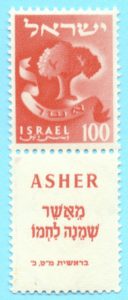 oenician plain . Here was some of the most productive land in Palestine-pasture, wooded hills, and orchards-noted especially for the abundance and richness of its olive-oil (Jewish Encyclopedia, tribe of Asher).
oenician plain . Here was some of the most productive land in Palestine-pasture, wooded hills, and orchards-noted especially for the abundance and richness of its olive-oil (Jewish Encyclopedia, tribe of Asher).
The oil would be so abundant, that Asher would dip his foot in it, so to speak. Because of this blessing concerning oil, the olive tree became an emblem of the tribe of Asher.
The Israeli postage stamp opposite again illustrates the connection between the olive tree and the tribe of Asher.
The emblem of the olive tree fits Asher for more than one reason. The olive tree is a symbol of prosperity or happiness; she gives rich food (the oil) and delicacies (the olives) (Gen 49:20).
Palm oil
The modern fulfilment of this statement concerning Asher’s oil can be found in palm oil which Belgium extracted from the Belgian Congo for years. Wikipedia: Palm oil production in the Congo increased from 2,500 tons in 1914 to 9,000 tons in 1921 and 230,000 tons in 1957.
Palm oil is an important ingredient in food and non-food products like margarine, chocolate, cleaning products and cosmetics. Palm oil has become one of the most important vegetable oils.
In 1959 Belgian Congo was the sixth biggest palm oil producer of the world … Asher ... let him dip his foot in oil.
8th Clue: 8. Asher, 9. Issachar, 10. Zebulun
… and [Leah] called his name Asher [8th son] … and [Leah] called his name Issachar [9th son] … and [Leah] called his name Zebulun [10th son] (Gen 30:13-20).
… of the tribe of the children of Zebulun, … of the tribe of the children of Issachar … of the tribe of the children of Asher … (Nu 34: 25-27).
And the third lot came up for the children of Zebulun … And the fourth lot came out to Issachar, for the children of lssachar… And the fifth lot came out for the tribe of the children of Asher …(Josh 19:10,17, 24).
Leah Tribes
Leah had eight sons, six of herself and two by her maidservant Zilpah. She named all eight of them. So there are eight Leah tribes (and five Rachel tribes). There is a bond between Asher, Issachar and Zebulun in both antiquity and in modern times.
Asher, Issachar and Zebulun are Jacob’s 8th, 9th and 1oth sons. They were close in age and were probably 20, 19 and 18 when Joseph (17) was sold. Apart from the cover-up they played no part in Joseph’s selling. Their minor role in that story is reflected by the minor role they would play in the history of the Ten Tribes in Israel, from the Exodus till the Assyrian Exile.
Their inheritance was only assigned to them after Moses’ death, after the important tribes had found their place. Seven pieces of land were described for the last seven tribes to be divided by casting lots (Josh 18-19). Zebulun, Issachar and Asher were the 3rd, 4th and 5th lot (Josh 19). They were closely connected in the drawing of lots.
Moreover all three of their tribal territories bordered the north of Manasseh, and their territories bordered each other, Zebulun in the middle. All three were in Galilee, far away from the centres of power (Hebron, Jerusalem, Samaria). In the Bible these three Leah tribes are insignificant tribes who lived far away in Galilee.
In the end-time the tribes of lssachar, Zebulun and Asher came to live in the Low Countries. Over the past 60 years there has been a close cooperation between these peoples within the Benelux (Belgium, Netherlands and Luxemburg) . They live closely together as they once did in Galilee, in Erets Yisrael.
9th Clue: Asher – mighty men of valour
All these were the children of Asher, heads of their father’s house, choice and MIGHTY MEN OF VALOUR, chief of the princes. And the number throughout the genealogy of them that were apt to the war and to battle was 26,000 men (I Chron 7:40).
And of Asher, such as went forth to battle, EXPERT IN WAR, 40,000 (1 Chron 12:36).
There were a few militaristic tribes, but Asher was not one of them. However, the Asherites were brave fighters. Although not an aggressive tribe, they could hold their ground when called upon.
Gallia Belgica -Roman Empire
(Map: Wikipedia)
Belgae – Julius Caesar
In his book Commentarii de bello Gallico Julius Caesar divides the Celts into three groups. The most northern group are the Belgae living in the area between the North Sea, Rhine, Seine and Marne. According to Caesar the Belgae were the bravest of the three groups. This quote from Caesar became very popular in the 1830’s in an attempt to enflame Belgian nationalism.
Belgium in WW I
The Belgians fought bravely under Soldier King Albert I against the German invasion.
Wikipedia: When World War I began, Germany invaded neutral Belgium and Luxembourg as part of the Schlieffen
Plan, trying to take Paris quickly. It was this action that caused the British to enter the war, as they were still bound by the 1839 agreement to protect Belgium in the event of a war. The Belgian army is remembered for their stubborn resistance during the early days of the war, with the army – around a tenth the size of the German Army – holding up the German offensive for nearly a month, giving the French and British forces time to prepare for the Marne counteroffensive later in the year. The German invaders treated any resistance such as sabotaging rail lines–as illegal and subversive, and shot the offenders and burned buildings in retaliation. Belgium had a prosperous economy in 1914 but after four years of occupation, it emerged ruined at the end of the war. On the other hand it suffered few deaths in combat.
10th Clue: Asher- peaceable, peaceful
And the prince of the tribe of the children of Asher, Ahihud the son of SHELOMI (Strong <08015>, shlomi, peacable) (Num 34:27).
The tribe of Asher is a peaceful tribe, not looking for war or trouble. This can first of all be concluded by the absence of things. There are no violent, negative, warlike stories or individuals known from the tribe of Asher in the Bible. Asher has a modest Biblical history with an absence of ringleaders in evil. The prince of Asher in Numbers 34 is even called Ahihud ben Shlomi, son of Shlomi (peaceful).
Asher is very modest in The Testament of Asher. There is no bragging like in some of the other testaments of the twelve patriarchs.
The olive tree is the symbol of Asher. This can also be connected to peace, as the olive branch is a symbol of peace.
Belgians – neutral & peaceful
The Belgians were more or less given their independence and their colonies. They were neutral twice and were invaded twice by the Germans. They fought bravely in WW 1 and WW 11 to defend themselves and their colonies, but they never attacked other nations.
Wikipedia about Belgian Herge’s comic book character Tintin: “… though in many situations Tintin can be classified as a pacifist, reflecting a dislike of war. At the beginning of Tintin and the Picaros, he is seen wearing a motorcycle helmet with a peace symbol on it. “
On the whole Belgians are peaceful people, more interested in food and drink than in war.
Anna of the tribe of Asher
Anna (Channah in Hebr.) of the tribe of Asher was in the temple (Lk 2:36) when Jesus was presented to the Lord by his parents. Channah means mercy or grace and Asher means happy.
Anna (=mercy) daughter of Phanuel (=face of God) from Asher (=happy) was happy and thankful for God’s mercy that she was chosen to welcome Jesus, the Prince of Peace (=shalom) to God’s Temple in Jerusalem.
There may be more prophetic clues concerning Asher Walloons (Belgians), but the above are the strongest in my opinion.

